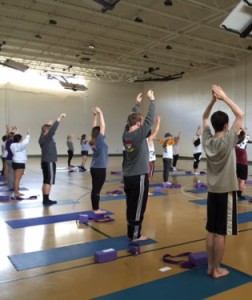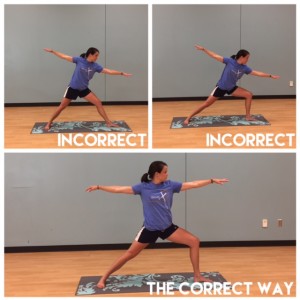When I walked into my first yoga class three months ago, I took one look at the room full of my obviously athletic and likely flexible peers and assumed that this would be an activity I would come to dread.
I’ve never been flexible, and my lack of balance and coordination rarely allows me to walk across a flat surface without tripping.
The class started out simple enough for a beginner such as myself, with a focus on breathing exercises. It wasn’t until we moved onto more involved poses that things became complicated.
I remember the first time I tried to do tree pose. A simple enough concept – you stand on one foot while the other leg is bent, your foot pressed flat against the inside of your straight leg. The pose is typically held for four to eight breaths. My poor balance allowed me to maintain this pose for roughly one inhale before I toppled over. Looking around the room, I noticed many other students holding the pose casually, without any noticeable signs of struggle.
“Listen to your own body and know what your limits are,” said Leigh Hilger, the professor for the course and a health and PE instructor with the school of teaching and learning at WCU. “Don’t focus on what your neighbor is doing.”
I’m sorry, we shouldn’t compare ourselves to our neighbor? But…how else will I know if I’ve succeeded?
That was the first time yoga enlightened me.
In today’s society, we are often conditioned to judge our successes and ourselves by the accomplishment or appearance of others. Everything from GPA’s, to high school SAT scores, to our relationships or sense of fashion are determined as ‘successful’ based on ‘the average’.
The purpose of yoga is not to judge ourselves, to be successful or trendy. Yoga should be practiced as a method of decreasing stress, calming our minds or improving ourselves based on our own standards.

A beginners yoga class practices sun salutations. Photo by Haley Smith
“We spend so much time these days trying to be perfect and engaging in comparing behaviors and body shaming,” said Michaela Birek, a yoga instructor at WCU’s Campus Recreation Center (CRC). “In yoga, if you’re doing it right, there’s no room for comparing or body shaming. It’s all about letting go of judgment of ourselves and of other people, and being grateful for the body we have.”
When I signed up for the course as a requirement to graduate, I had no idea it would have such a lasting impact on my lifestyle.
Now, if I go more than a week without practicing yoga, my body feels tense and I become irritable or frustrated about small problems.
I often reflect on how amazing it has been to see the difference in my own body after practicing yoga. My balance and coordination have improved. My sleeping and eating habits as well as my overall mood have been positively affected by the addition of yoga in my life.
Benefits of yoga
Extensive research has been done about the mental and physical benefits of practicing yoga regularly.
Yoga can be beneficial to your immune system – certain poses help clear sinuses and help you breathe better. Yoga encourages increased breath volume, but fewer overall breaths. This expands your lung capacity and calms your heart rate during exercise.
Hilger said that posture, flexibility and pain – specifically back pain – are some of the things that regular yoga practice helps.
“We [lowered blood pressure] over the course of the semester more often in yoga courses than in general health classes because we’re focused on finding inner peace,” said Hilger.
Hilger said that decreased anxiety, calming of the mind and increased focus are some of the mental benefits of regular yoga practice.
“Mentally, we get better at focusing and being present and getting rid of all of the distraction,” said Hilger.
For Birek, who said that yoga has helped her become more fit mentally and physically, yoga is a time to “take care of [herself].”
“I’m able to stay in the present moment, not just while I’m on my mat, but in day-to-day life, talking to friends or paying attention in class,” said Birek.
Hilger said she especially likes that yoga can help build self-esteem in people who practice it. She drew attention to the fact that she teaches her yoga courses in a room with no mirrors.
The benefit of practicing yoga in a mirrored room, according to Hilger, is the ability to see changes in your body’s alignment – particularly when practicing new and unfamiliar poses.
“What I like about being in a room without mirrors is that we grow more attuned to what our body is doing and we’re not judging our body. When we’re doing yoga in front of a mirror and we see that, everyone else has their leg way up here and I don’t, we judge ourselves,” said Hilger.
Yoga styles
There are many different styles of yoga, and each one focuses on improving different aspects of your mind and body, but they all have the same judgment-free maxim. Gaiam Life published an article on A Beginners Guide to Eight Major Styles of Yoga, to better explain the differences between them.
Hilger usually teaches ashtanga flow yoga, which is a style of yoga that was modernized by Sri K. Pattabhi Jois. Ashtanga yoga moves between poses to increase heart rate, generate heat in the body and synchronize breathing.
“I had heard about yoga for so long and thought it wasn’t for me because it was for people who were amazingly flexible,” said Hilger. “Not only did I start doing it, but I pursued getting trained in it and started teaching it.”
Three of the CRC’s yoga instructors, including Birek and Hilger, were trained through YogaFit, which is a yoga fitness education program designed to teach instructors at health clubs and fitness facilities.
“During my classes, I make an effort to use transformational language and help my participants focus on the YogaFit essence, which is: breathing, feeling, listening to the body, letting go of judgment and expectations, and staying in the present moment,” said Birek.
According to Birek, the CRC has had 600 total participations in yoga throughout the semester.
Hilger said this yoga style helps “bring yoga to the masses” by “simplifying the more spiritual aspects and making it more palatable to people in America.”
“People who thought that yoga was just for weird hippies in the 70’s now realize that it has a lot of physical benefits that we all can benefit from,” said Hilger. “Yoga is about finding inner peace, and we all need that.”
The CRC sees a slight decrease in yoga participation during the more stressful times of the semester, according to Birek.
“Unfortunately, when people probably need fitness and relaxation the most, it’s the first thing to go when things get stressful!” said Birek.

Birek demonstrates Warrior II, one of the yoga poses that are commonly done incorrectly, and shows how to do it right. Photos by Haley Smith.
According to Birek, yoga is one of the most popular classes offered at the CRC. They usually run four classes every semester, unless they are short on certified instructors.
The increased popularity of yoga in mainstream society is a very good thing, according to Hilger.
“I think we have to keep the integrity of what yoga is, and I think that might be a challenge in our Western culture” said Hilger. “It shouldn’t become just another way to get a really intense workout.”
Recent trends in the practice of ‘hot yoga’ have been a cause for concern for many experts and professionals. Hot yoga is one of the ways that western culture has taken to transforming yoga from a relaxing exercise into an exhausting workout.
Hot yoga is a bit like doing exercise in the middle of a sauna. Although the yoga poses are much the same as any other yoga style, the room that the yoga is practiced in is kept at a stifling 105 degrees Fahrenheit.
Hilger is one of many who are concerned about the potential negative side effects of hot yoga. According to Hilger, practicing yoga in a room with such high temperatures creates significantly more heat in the body and increases sweating. This results in the need to consume more water in order to keep up with the liquid being expelled through the sweat in your body.
It is important that we feel good after attending a yoga class, not as if we’ve been beaten up, according to Hilger.
“Its not just a physical journey,” said Hilger. “Its also an emotional journey and a psychological journey.”
Watch the video below to see Birek discuss some of the yoga poses that people commonly perform incorrectly and how this can be harmful to your body.
Should you take yoga?
Hilger insists that people should not postpone trying yoga because of their own beliefs about the limitations of their body.
“Yoga is for everyone,” said Hilger. “You don’t need to wait until you’re super flexible to be able to go to yoga class.”
Birek said the yoga classes she teaches focus on the “meditation and mindfulness” aspects of yoga instead of “power and strength.”
“I enjoy the breathing and mindfulness aspect of yoga,” said Birek. “Think about it. When was the last time you noticed the sound of your own breath moving in and out of your body? That’s a powerful thing.”
Hilger likes the “accessibility” of yoga. Even if the spiritual aspect of yoga becomes lost in the mainstream, Hilger believes that people can rediscover those aspects with continued involvement in the practice.
Resources such as Yoga Journal magazine or yoga retreats help people become more involved in the world of yoga.
“My hope is that we have swung from yoga being this ‘spiritual thing’ where, if you’re Christian you can’t do yoga, to it becoming a very physical thing,” said Hilger. “That may be an entryway for people to seek out the other aspects of yoga.”
I’ve been practicing yoga for three months now and my balance and coordination have improved noticeably. About a month ago, I shifted my body into tree pose and didn’t notice until I was about three breaths into it that I hadn’t lost my balance yet. Of course, drawing my attention to this fact caused me to lose focus and stumble out of the pose, but I’m getting better.
I don’t look around the room anymore, and I’ve become better at clearing my mind for the duration of practice. I’m still learning to let go of my self-judgment and perfectionist tendencies, but I’ve come to the realization that not perfecting a pose on the first try doesn’t mean that I’ve failed, it just gives me something to aim for.
That’s one of the most beautiful things about yoga – it always has something new to teach you.


